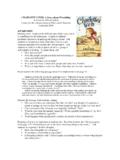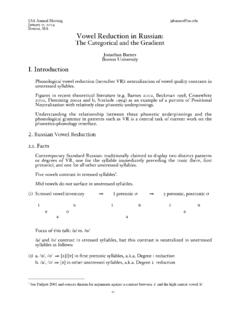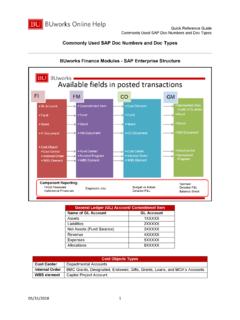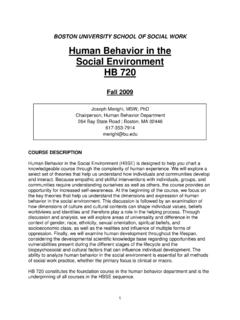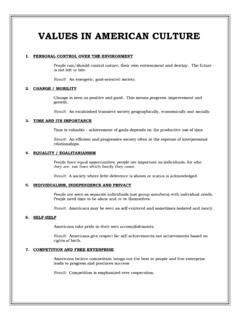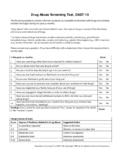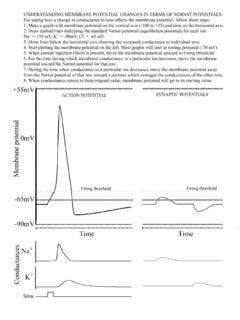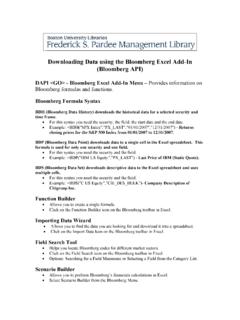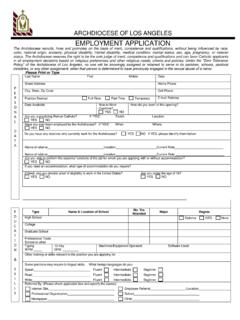Transcription of Chapter 8, Acid-base equilibria - Boston University
1 Chapter 8, Acid-base equilibriaRoad map of Acid-base equilibriaOn first encounter, the study of Acid-base equilibria is a little like a strange land with seemingly confusing trails that make passage difficult. In fact, there is a road map that, once understood, allows us to navigate Acid-base equilibria with confident precision and so become masters of its domain. Here is an overview of this road , aqueous Acid-base equilibria are just a particular example of the ideas and techniques we have already learned in the study of gas phase chemical equilibria . However, there are two aspects that complicate the application of these ideas. First, because the autoionization of water,2H2 OHlLFH3 O+ HaqL+OH- HaqL,Kw,is always present in aqueous solution, the analysis of aqueous Acid-base equilibria must always take into account at least two competing equilibria , the acid or base ionization and the water autoionization. Second, because we will be interested in how Acid-base equilibria respond to changes in the system (typically by adding additional base or acid ), we need also to be able to separate the chemical reactions that take place when things are combined from the subsequent equilibration of the reaction product.
2 The key idea is to let what are combined react 100% as a limiting reagent problem as a preliminary step done before overarching goal, then, is to learn to clearly distinguish and to separately master these two aspects competing equilibria and limiting reagent reactions. Once this is achieved, we will have a framework in which any problem in aqueous Acid-base equilibria can be solved in a straightforward approach we take is to distinguish four regimes: 1. pure acid (or base ) solution, 2. acid (or base ) that has been partially consumed by addition of base (or acid ),3. acid (or base ) that has been exactly consumed by addition of base (or acid ),4. acid (or base ) that has been consumed by reaction with excess base (or acid ).The details will be different depending on whether the acid (or base ) initially present is a weak or strong acid (or base ), that is, whether its ionization constant is large or small compared with 1. In all cases, the other component will be a strong base (or acid ).
3 The first regime is a straightforward equilibrium problem. The second regime involves reaction of the acid and base as a limiting reagent problem, followed by straightforward equilibration of the resulting solution. The third regime is handled differently depending on whether the acid (or base ) initially present is a weak or strong acid (or base ). The fourth regime, like the second, involves reaction of the acid and base as a limiting reagent problem, but then equilibration of the products is simple since it will always be the excess base (or acid ) that is left after the limiting reagent will know that you have mastered this road map of Acid-base equilibria when you approach such an equilibrium as a two step process: First (always!), determine which regime applies. Then, implement the calculational procedure for that regime to determine the chemical equilibrium. That really is all there is to it. In this way you can come to find that things will seem simple; not easy, but , our plan is to learn about each of the four different regimes.
4 We'll do this for each one in turn. Then we'll see how to put everything together, to construct a titration curve the variation of pH throughout the four regimes. Finally, we'll construct a compact summary of the road let's begin, by defining just what Acid-base reactions are and how to characterize reactionsWe are going to be working with Acid-base equilibria in aqueous solution, and we will use the Br nsted-Lowry definitions that an acid is a source of H+ and a base is an acceptor of H+. acid ionization constant KaA convenient way to write the reaction of an acid HA in water is HAHaqL+H2 OHlLFH3 O+ HaqL+A- water is acting as a base , accepting the H+; the result, H3O+, called the conjugate acid of H2O, since H3O+ can donate H+ to reform H2O. In a similar way, A- is called the conjugate base of the acid HA, since A- can accept H+ to reform HA. The equilibrium constant is known as the acid ionization constant Ka, Ka=H@H3O+D 1ML H@A-D 1ML H@HAD 1ML,where the reference concentration, 1 M, is written explicitly; liquid water does not appear, because its reference concentration is just the liquid water, so its activity is 1.
5 (Strictly, we are assuming that solutes are sufficiently dilute that the concentration of the water is negligibly affected by their presence.) Usually, we will abbreviate Ka as Ka=@H3O+D@A-D @HAD,with the understanding that [..] stands for the numerical value without units of the concentration in mol/L. As usual, Ka is unit-less. An example acid ionization is CH3 COOHHaqL+H2 OHlLFH3 O+ HaqL+CH3 COO-HaqL,Ka=@H3O+D@CH3 COO-D Ka is much greater than 1, the acid is mostly dissociated and so is said to be a strong acid . If Ka is much less than 1, the acid is dissociated only to a small extent and so is said to be a weak acid . base ionization constant KbSimilarly, we can write the reaction of a base B in water as 206 Notes on General Chemistry, 2eCopyright 2006 Dan Dill All rights reservedH2 OHlL+BHaqLFHB+ HaqL+OH- water is acting as an acid , donating the H+; the result, OH-, is called the conjugate base of H2O, since OH- can accept H+ to reform H2O.
6 Analogously, HB+ is called the conjugate acid of the base B, since HB+ can donate H+ to reform B. The equilibrium constant is known as the base ionization constant Kb,Kb=@HB+D@OH-D we have used the abbreviated form. Here is an example base ionization, H2 OHlL+NH3 HaqLFNH4+ HaqL+OH- HaqL,Kb=@NH4+D@OH-D Kb is much greater than 1, the base reacts nearly completely with water and so is said to be a strong base . If Kb is much less than 1, the base reacts hardly at all with water and so is said to be a weak base . Water autoionization constant KwIn this analysis of acid and base ionization we see that water in one case plays the role of a base and the other plays the role of an acid . Indeed, the role that water plays in an aqueous equilibrium can be used as another definition of acid or base . A consequence of this dual role of water is that its equilibrium with H3O+ and OH- is the reference standard against which aqueous acidity and basicity are is how this works.
7 A general base ionization reaction is H2 OHlL+BHaqLFHB+ HaqL+OH- HaqL,Kb,and the ionization reaction of its conjugate acid is HB+ HaqL+H2 OHlLFH3 O+ HaqL+BHaqL, sum of these two reactions is 2H2 OHlLFH3 O+ HaqL+OH- HaqL, equation is called the autoionization of water and its equilibrium constant is known as the water autoionization constant Kw. At 25 C it is equal to Kw=@ 10-14 Now, we have seen that the equilibrium constant of a sum of two reactions is the product of the equilibrium constants of the summed reactions. Therefore, we know that water autoionization constant can be expressed asKw= 8, Acid-base equilibria207 Copyright 2006 Dan Dill All rights reservedThis means we can compute the base ionization constant from the ionization constant of its conjugate acid , Kb=Kw Ka=10-14 Ka,where the last equality is for 25 C. It is for this reason that base ionization constants are generally not tabulated. pHBecause Kw is so small, water is ionized only very slightly.
8 We can compute the concentration of H3O+ and OH- by solving the autoionization equilibrium. @H3O+D M@OH D Minitial 0 0equilibrium x xInitial and equilibrium activities for the autoionization of liquid equilibrium expression is thenKw=1. 10-14=x2and so the concentration of H3O+ and OH- are each 1 10-7 M at 25 , as we will see in a moment, strong acids can have H3O+ concentrations of 1 M or more. This means that H3O+ varies over many powers of 10 (orders of magnitude), and so it is convenient to measure [H3O+] on a logarithmic scale. Also, for weak acids and bases, which is what we will be interested in primarily, concentrations of H3O+ and OH- are generally much less than 1 M, which means their logarithms are negative, and so it is more convenient to work with the negative logarithms so that we have a positive quantity. For this reason, the notation pAnything is defined aspAnything=-log10 HAnythingLand in particular pH and pOH are defined as pH=-log10 H@H3O+D 1 ML=-log10H@H3O+DL,pOH=-log10 H@OH-D 1ML=-log10H@OH-DL,where in each case the second equality is written with understanding that [.]
9 ] stands for the numerical value without units of the concentration in that pure water at 25 C haspH=pOH= get a feeling for the amounts involved, how many OH- ions are present in 1 liter of pure water at 25 C? How many H2O molecules are present? The molecules and ions present in water are constantly buffeting one another. On average, how many collisions does a water molecule make before it encounters an hydroxide ion?Since acids produce additional H3O+, their pH is always less than 7. Similarly, since bases produce additional OH-, their pOH is always less than 7. We can relate pH and pOH, by calculating pKw. 208 Notes on General Chemistry, 2eCopyright 2006 Dan Dill All rights reservedpKw=-log10 HKwL=-log10 H@H3O+D@OH-DL=-8log10H@H3O+DL+log10H@OH- DL<=-log10H@H3O+DL-log10H@OH-DL=pH+pOHTh is means that at 25 CpH= that bases have pH greater than 7, at 25 C. Calculate the pH and pOH of the following HCl solutions, assuming the HCl dissociates 100%: 15 M, 10 M, 5 M, 1 M, M and M.
10 Can pH be less than 0?Calculate the pH and pOH of the following NAOH solutions, assuming the NaOH dissociates 100%: 15 M, 10 M, 5 M, 1 M, M and M. Can pH be greater than 14?It is important always to be mindful of the temperature being used. The reason is that equilibrium constants in general, and the value of Kw in particular, are different at different temperatures. This means that the pH of pure water will be different at different temperatures. For this reason, saying a solution has pH = 7 does not, by itself, mean the solution is "neutral" (has equal concentrations of H3O+ and OH-. More generally, the acidic or basic character of a solution is due to the relative concentrations of H3O+ and OH-, rather than a particular numerical value of pH. Like all equilibrium constants, the autoionization constant of water changes with temperature. At 10 C its value is 10-14 and at 30 C its value is 10-14. Calculate the pH and pOH of water at 10 C and 30 C.)
